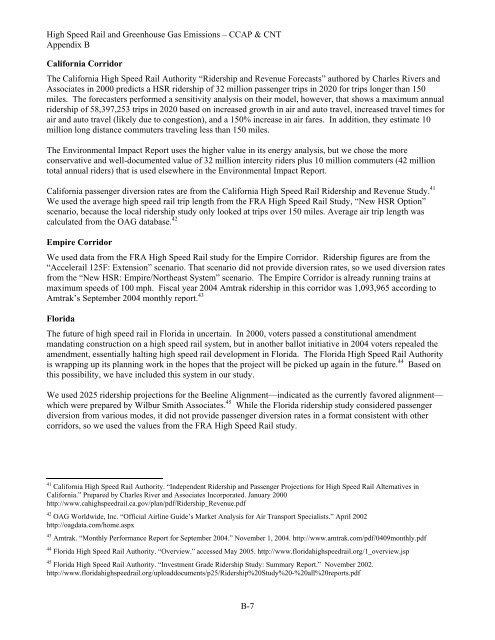High Speed Rail - Center for Neighborhood Technology
High Speed Rail - Center for Neighborhood Technology
High Speed Rail - Center for Neighborhood Technology
You also want an ePaper? Increase the reach of your titles
YUMPU automatically turns print PDFs into web optimized ePapers that Google loves.
<strong>High</strong> <strong>Speed</strong> <strong>Rail</strong> and Greenhouse Gas Emissions – CCAP & CNT<br />
Appendix B<br />
Cali<strong>for</strong>nia Corridor<br />
The Cali<strong>for</strong>nia <strong>High</strong> <strong>Speed</strong> <strong>Rail</strong> Authority “Ridership and Revenue Forecasts” authored by Charles Rivers and<br />
Associates in 2000 predicts a HSR ridership of 32 million passenger trips in 2020 <strong>for</strong> trips longer than 150<br />
miles. The <strong>for</strong>ecasters per<strong>for</strong>med a sensitivity analysis on their model, however, that shows a maximum annual<br />
ridership of 58,397,253 trips in 2020 based on increased growth in air and auto travel, increased travel times <strong>for</strong><br />
air and auto travel (likely due to congestion), and a 150% increase in air fares. In addition, they estimate 10<br />
million long distance commuters traveling less than 150 miles.<br />
The Environmental Impact Report uses the higher value in its energy analysis, but we chose the more<br />
conservative and well-documented value of 32 million intercity riders plus 10 million commuters (42 million<br />
total annual riders) that is used elsewhere in the Environmental Impact Report.<br />
Cali<strong>for</strong>nia passenger diversion rates are from the Cali<strong>for</strong>nia <strong>High</strong> <strong>Speed</strong> <strong>Rail</strong> Ridership and Revenue Study. 41<br />
We used the average high speed rail trip length from the FRA <strong>High</strong> <strong>Speed</strong> <strong>Rail</strong> Study, “New HSR Option”<br />
scenario, because the local ridership study only looked at trips over 150 miles. Average air trip length was<br />
calculated from the OAG database. 42<br />
Empire Corridor<br />
We used data from the FRA <strong>High</strong> <strong>Speed</strong> <strong>Rail</strong> study <strong>for</strong> the Empire Corridor. Ridership figures are from the<br />
“Accelerail 125F: Extension” scenario. That scenario did not provide diversion rates, so we used diversion rates<br />
from the “New HSR: Empire/Northeast System” scenario. The Empire Corridor is already running trains at<br />
maximum speeds of 100 mph. Fiscal year 2004 Amtrak ridership in this corridor was 1,093,965 according to<br />
Amtrak’s September 2004 monthly report. 43<br />
Florida<br />
The future of high speed rail in Florida in uncertain. In 2000, voters passed a constitutional amendment<br />
mandating construction on a high speed rail system, but in another ballot initiative in 2004 voters repealed the<br />
amendment, essentially halting high speed rail development in Florida. The Florida <strong>High</strong> <strong>Speed</strong> <strong>Rail</strong> Authority<br />
is wrapping up its planning work in the hopes that the project will be picked up again in the future. 44 Based on<br />
this possibility, we have included this system in our study.<br />
We used 2025 ridership projections <strong>for</strong> the Beeline Alignment—indicated as the currently favored alignment—<br />
which were prepared by Wilbur Smith Associates. 45 While the Florida ridership study considered passenger<br />
diversion from various modes, it did not provide passenger diversion rates in a <strong>for</strong>mat consistent with other<br />
corridors, so we used the values from the FRA <strong>High</strong> <strong>Speed</strong> <strong>Rail</strong> study.<br />
41 Cali<strong>for</strong>nia <strong>High</strong> <strong>Speed</strong> <strong>Rail</strong> Authority. “Independent Ridership and Passenger Projections <strong>for</strong> <strong>High</strong> <strong>Speed</strong> <strong>Rail</strong> Alternatives in<br />
Cali<strong>for</strong>nia.” Prepared by Charles River and Associates Incorporated. January 2000<br />
http://www.cahighspeedrail.ca.gov/plan/pdf/Ridership_Revenue.pdf<br />
42<br />
OAG Worldwide, Inc. “Official Airline Guide’s Market Analysis <strong>for</strong> Air Transport Specialists.” April 2002<br />
http://oagdata.com/home.aspx<br />
43 Amtrak. “Monthly Per<strong>for</strong>mance Report <strong>for</strong> September 2004.” November 1, 2004. http://www.amtrak.com/pdf/0409monthly.pdf<br />
44 Florida <strong>High</strong> <strong>Speed</strong> <strong>Rail</strong> Authority. “Overview.” accessed May 2005. http://www.floridahighspeedrail.org/1_overview.jsp<br />
45 Florida <strong>High</strong> <strong>Speed</strong> <strong>Rail</strong> Authority. “Investment Grade Ridership Study: Summary Report.” November 2002.<br />
http://www.floridahighspeedrail.org/uploaddocuments/p25/Ridership%20Study%20-%20all%20reports.pdf<br />
B-7



